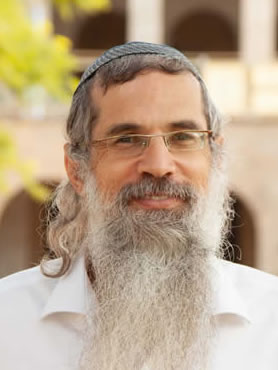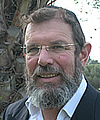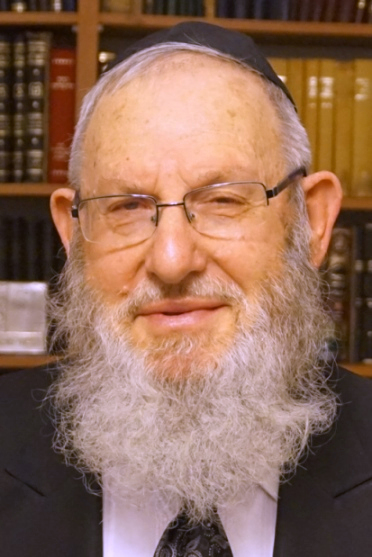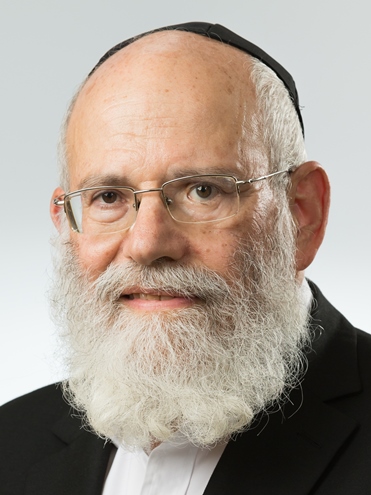Constraining the Torah
הרב אברהם ריבלין, המשגיח הרוחני לשעבר
Israel's two big sins through the course of history are the sin of the golden calf and the sin of the spies. The dates of these sins are also known. The sin of the golden calf occurred on 17 Tammuz (forty days after Moshe received the Torah at Har Sinai). The sin of the spies occurred on 9 Av, as Chazal comment: "You cried a needless cry; I will establish for you a day of crying for generations." (Ta'anit 29a)
There is another, less known, sin – that of selling Yosef. As a group, this was the first sin of the nation. Yet, the Torah does not relate to this so much as a sin, the way it does to the golden calf and the spies, where G-d responds and rebukes. (For this reason, it is necessary to explain the rationale and behavior of the brothers.) Nonetheless, Am Yisrael paid a price for this, specifically in ways relating to Amalek and Rome. Chazal draw a parallel between the verse, "The king and Haman sat down to drink" (Esther 3:15), and what is said regarding the sale of Yosef, "They sat down to eat bread." (Bereishit 37:25) The Midrash teaches: "You sold your brother through eating and drinking; so, too, I will do to you." (Esther Rabbah 7:25) The other punishment is the ten martyrs of the Romans, which is portrayed as punishment for the sale of Yosef. Although in the kinah this idea is presented as the claim of the Roman Emperor, presumably it indicates a true hashkafic connection. Hagaon Rav Shlomo Fisher shlita suggests that this occurred on 10 Tevet. Indeed, the constellation of the month of Tevet is a goat, which is associated with the sale of Yosef: "They slaughtered a goatling." (Bereishit 37:31)
We also find the sale of Yosef associated with the sin of the golden calf. On the pasuk, "Eshkol hakofer dodi li bekarmei Ein Gedi" (Shir Hashirim 1:14), the Gemara (Shabbat 88b) comments: "The Master of all will atone for the sin of the kid goat that I added to myself." Rashi interprets this as referring to the sin of the golden calf. Similarly, on the pasuk, "Take a he-goat for a sin-offering" (Vayikra 9:3), the Sifra comments: "You have [a sin] at the beginning and you have [a sin] at the end. You have at the beginning: 'They slaughtered a goatling.' And you have at the end: 'They made for themselves a molten calf.'" Why is the sale of Yosef associated with the golden calf?
On the basis of Rav Fisher's suggestion, we would like to explain the connection between 10 Tevet and the sale of Yosef on a hashkafic level. After all, clearly a fast day is not just to commemorate the events of the past, but also to repent and restore. We will speak first of 10 Tevet, then of the sin of the golden calf, then of Chanukah, and, finally, of the sale of Yosef.
In the Selichot for 10 Tevet we say:
????? ???÷ ??? ?????; ?????? ???? ????? ?? ???? ...
In other words, 10 Tevet is the summation of three events that occurred on 8, 9, and 10 Tevet.
????? ?????? ?? ?????? ??????, ??? ????? ÷???? ?????;???? ??? ????? ????? ?? ?????; ?? ??? ???? ?????? ?????? ?????.
This alludes to what we find in Masechet Sofrim 1:7 that on 8 Tevet the Torah was translated to Greek: "There were five elders who wrote the Torah in Greek for King Talmai, and the day was as traumatic for Israel as the day on which the calf was made, because the Torah could not be translated sufficiently." In other sources, we find that darkness came to the world for three days.
?????? ????? ?? ?????? ????, ??? ???? ???? ??? ????;???? ???? ?? ????? ???? ???, ??? ???? ?????.
In the Shulchan Aruch (O.C. 580:2) it says that it is not clear what occurred on 9 Tevet. The Magen Avraham and Taz write that Ezra died on this day. (The B'hag adds that Nehemiah also died then.) Regarding 10 Tevet there are explicit verses in the Tanach: "The word of Hashem came to me ... in the tenth month, on the tenth of the month saying, 'Son of Man, write for yourself the name of this day – this very day; the king of Babylonia has reached Jerusalem on this very day." (Yechezkel 24:2) [Since it says, "this very day," we learn that if it were possible for 10 Tevet to occur on Shabbat, it would supersede Shabbat, even though when 9 Av occurs on Shabbat the fast is postponed. On a certain level, then, 10 Tevet is a more severe day.]
Let us speak about the translation of the Torah, which is included in the fast of 10 Tevet. What is so traumatic about it that it caused three days of darkness? While it may be bad, but how can it be compared to the sin of the golden calf?! Furthermore, R. Yonatan Eibshutz (Ya'arot Devash #2) asks, the Torah was already translated to seventy languages at Mt. Gerizim and Mt. Eval! We are intended to serve as a light to the nations, and the Jewish ideal is: "Let every creature know that You created him!" "To establish the world with G-d's dominion!" This can only be accomplished through spreading the Torah to the entire world, so what is so terrible?
On Chanukah we spoke of the Written Torah and the Oral Torah. The Written Torah is similar to Moshe Rabbeinu; it is exactly as it is given, and there is no hypothesis and conclusion. Yet, there are seventy facets to the Torah. The Oral Torah is also given from Heaven, but its underpinning is human input, for man to add his share and understanding in Torah. Therefore, we find disputes in the Oral Torah. Just as people's faces are different, so, too, their opinions are not identical. There is a multiplicity of opinions: "Many are the peace of your children." The truth of the Torah is expressed through the multiplicity of opinions and shades, and the harmony of them all – forms unity.
This is the reason for Greece's objection to the Torah. "'[People] will travel from sea to sea, and from north to east; they will wander about to seek the word of Hashem, but they will not find it. (Amos 8:12) 'The word of Hashem' – this is the Halacha." (Shabbat 138b) Science is orderly and systematic, whereas the Oral Torah is not so orderly, and at the beginning one has trouble understanding it at all. Therefore, as Rav Hutner zt"l writes, "The Greek academy aims its poison arrows at the Oral Torah." However, after one learns, he understands that Torah is "like a hammer that shatters a stone" (Yirmiya 23:29), just as life itself has many varied circumstances and opinions – and yet we manage to form a harmony.
On the first day of Creation, G-d created light, a special light that was later hidden. What was there to see with this light? There was no world yet! The light showed that: "There is nothing other than He." (Devarim 4:31) There is nothing else to see, and everything else is a world of falsehood. Everything else that was created hides His existence – a mountain, the stars, etc. We do not aim to be ascetic, but we have to be aware that we are not seeing the absolute truth. We see the ocean, not the Divine element that is inherent in it. This seeing of material objects is darkness and falsehood. The truth is: "There is nothing other than He." This is what was seen with that light, and, in the future, we will see it once again. This is one of the ideas of Chanukah; the thirty-six lights correspond to the thirty-six hidden righteous people.
Yeshaya says: "Raise your eyes on high and see who created these (mi bara eileh)." (Yeshaya 40:26) The combination of these letters, mi and eileh, is Elokim. The Zohar teaches that mi is the most hidden, and eileh is the revealed of the hidden; the hidden light, in contrast to our light. Elokim is characterized by mi – who? It is impossible to say anything about Him, and even when we say – "great, mighty and awesome," we are not referring to the Divine itself, but to His Revelation to us. Any word serves to define and limit. If someone says, "I am walking," this implies: "I" – and not someone else; "walking" – and not some other activity. The description, "great" – limits, and it is impossible to limit the Divine, not to mention the Rambam's point that any description is an understatement.
Thus, the Divine is mi, in contrast to eileh. The mi created the eileh, the observable nature, which is His Revelation. We should not view nature as if it is the Divine; this is heresy. Am Yisrael, though, at the golden calf, said: "eileh elohecha Yisrael – This is your god, Israel." To take one aspect of the Divine, such as nature, and view it as G-d is idolatry. It does not make a difference whether we single out only one aspect of the Divine teaching or all of nature. There are other worlds that we do not comprehend. Only with the hidden light can we see from one end of the world to the other, or through the Torah with its seventy facets. The harmonious blend of them all creates the absolute Truth.
Based on this we can understand the comparison of the translation of the Torah to the sin of the golden calf, and the reason it was considered a traumatic day. What happens when something is translated? The Torah has four fundamental levels of interpretation (Pardes): pshat (simple meaning), drash, remez, and sod. Even within the simple meaning there are various ways of understanding. The Torah is all-comprehensive, and there is nothing that is not alluded to in the Torah. It is also possible to read the letters of the Torah with different word divisions. For example, the opening words of the Torah: ?????? ??? can be divided: ???? ?????, which are allusions to G-d. (Thus, we say that the Torah was initially written in black fire on a background of white fire.) Another example, related to Yosef: Parts of the phrase: ??? ???? ???? ???? can be divided as: ??? ??? (Rachel died, so how can the moon, i.e., your mother, bow down to you). Thus, while on the surface the Torah is fixed, there is a tremendous depth and flexibility.
Through translating the Torah into Greek, the Torah was converted from a lion in the jungle into a lion in a cage. What is the difference? Everyone is fearful of a lion in a jungle. It is awesome and majestic; it pounces from here and from there. On the other hand, in a cage – is this what everyone is so afraid of? Anything that is constrained and presented as: "This is it!" – loses its greatness. In a translation there is no possibility of conveying all of the richness of the Torah, such as mentioned above, but only one understanding. There are also verses that can be punctuated differently, with certain words being read with either the preceding or following words, such as: "??? ???? ????÷ ??? ???? ??? ?? ??? ?????". Where does the "tomorrow" belong, before or after?
When translating, only one interpretation can be used. It is like capturing a lion in the jungle and locking it in a cage. It is taking the seventy facets of Torah and looking at it in a defined way. This is exactly the sin of the golden calf: "This is your god, Israel." To take one small part or facet of the Divine Revelation, which is expressed also in spiritual worlds, and to say, "This is it!" – is the sin of the golden calf!
Why, then, did G-d command to translate the Torah into seventy languages? R. Eibshutz answers that since this was done immediately after Moshe's death, there was still the quality of Moshe Rabbeinu, and the ability to incorporate everything in a written format. It was a special translation that accommodated all of the Oral Torah. (This is hard to understand.)
We can suggest two other possibilities. First of all, there is a difference between translation into a single language and into seventy tongues. Seventy does not seem to be merely a number indicating multitude, but rather a multiplicity of multiplicity. Thus, there remains the possibility for various shades and possibilities. The seventy nations jointly express all of existence. This is the idea of the hidden light that shone from one end of the world to the other, and this is why the Torah commanded to translate into seventy tongues – all of the possibilities. The Torah still remained a lion in the jungle. "Verav shalom banayich – Many are the peace of your children." The Torah is not one identical idea, but rather the harmony of different opinions. This view, and that view, and the other view – all blend to form the Divine Truth, but not a translation of one facet.
Man is called "speaker," since speech is what identifies him and sets him apart from other creatures. The same is true for a language on the national level. (Thus, we say in the Shema blessing, "You chose us from all nations and tongues.") In Parshat Noach we find: "by their families, by their languages." (Bereishit 10:20,31) We can learn about the nature of a nation from its language. The seventy languages are not merely languages, but rather signify seventy natures. A translation into seventy languages retains multiplicity, but not into one language, which presents only one facet: "This is the Torah."
It is further possible that darkness came to the world because of the Greek wisdom. Perhaps translation into English, or some other language, would not have been so terrible. To translate into Greek, though, whose very essence was to seek a single understanding, and to deny any holiness and Divine element – this was the tragedy. This is the connection between 10 Tevet and the death of Ezra. Ezra the Scribe represents the Oral Torah; he was in the crossover generation between the prophets and the members of Knesset Hagedolah. On the one hand, they edited and completed the Tanach, and, on the other hand, they began the era of the Oral Torah.
On a national level, the sale of Yosef signifies the same idea. Yaakov had thirteen children. Even though he bore only twelve, he says: "Ephraim and Menashe shall be mine like Reuven and Shimon." (Bereishit 48:5) With this we can understand Reuven's sin. Yaakov sought a thirteenth son from Bilha, but Reuven sought his mother's honor, and disrupted Yaakov – thus there remained only twelve.
Avraham, Yitzchak and Yaakov were individuals. As Bnei Yisrael became a nation, though, there was the danger of fragmentation into tribes – twelve individual tribes. Devorah complains about this (cf. Shoftim 5:15-17), and when Shaul is anointed and faces war with Amon, he sends an ox dismembered into twelve pieces throughout all of Israel to rally them all together (cf. Shmuel I 11:7). This was not just a threat to those who wouldn't come, but rather a message that twelve disjointed pieces do not have the power of an ox, only when the pieces are united together as one unit. That is why in the first generation of the nation, the number of tribes has to be thirteen, which is the numerical value of echad (one) and of ahava (love). Since Reuven sinned and prevented the formation of the thirteenth son, and he was also the firstborn, he was responsible to rectify this loss. That is why he said, "The child is gone! And I – where can I go?" (Bereishit 37:30) What was he so concerned about? "The child is gone!" – He had tried to save Yosef, who was destined to father the additional child, but now the thirteenth child is gone. What will I do?!
We explained, on other occasions, that the thirteen tribes are not by chance. Rather, "like Rachel and like Leah who together built the House of Israel." (Ruth 4:11) Avraham exemplified the trait of chesed, and was complemented by Sarah, who had the trait of gevurah. Yitzchak and Rivka were the opposite. Yaakov, who exemplified emet (truth, the synthesis of the two), needed two wives to complement him: Rachel was from the "revealed world" and Leah from the "hidden world." Yosef descended from Rachel. The truth of Yaakov is expressed through the combination of Rachel and Leah – emet, from aleph to tav, from one end of the world to the other. The other sons thought that just as with their ancestors one son was cast off in favor of the other, so, too, here. They did not understand that Yaakov was different, and that all of his descendents were righteous. This parallels the mistake of the golden calf, and the translation of the Torah – taking one part and forgetting that there is a much larger whole. Mi – Eileh.
10 Tevet is the day on which the siege of Yerushalayim began. Yerushalayim is the city that joins the people of Israel together, and was not divided to one tribe or the other.
Our job, in addition to fasting, is to strengthen this idea: To recognize the validity not only of what I think, but also the validity of others, both in terms of acts of kindness and tolerance of opinion.
Together we will raise G-d's Crown, and merit the hidden light.
קוד השיעור: 4053
(Translated by Rav Meir Orlian) Sicha delivered 10 Tevet 5764
לשליחת שאלה או הארה בנוגע לשיעור:






